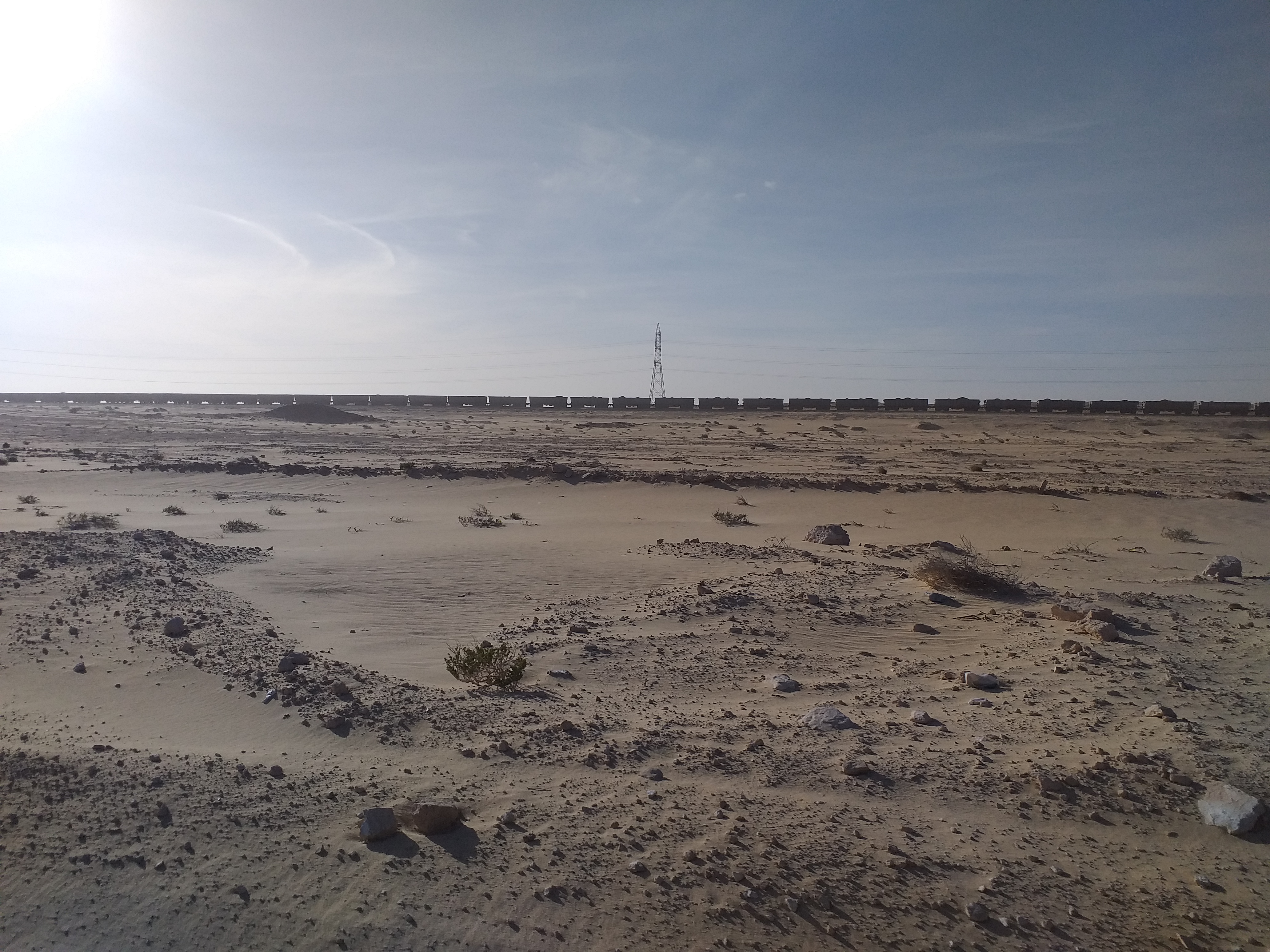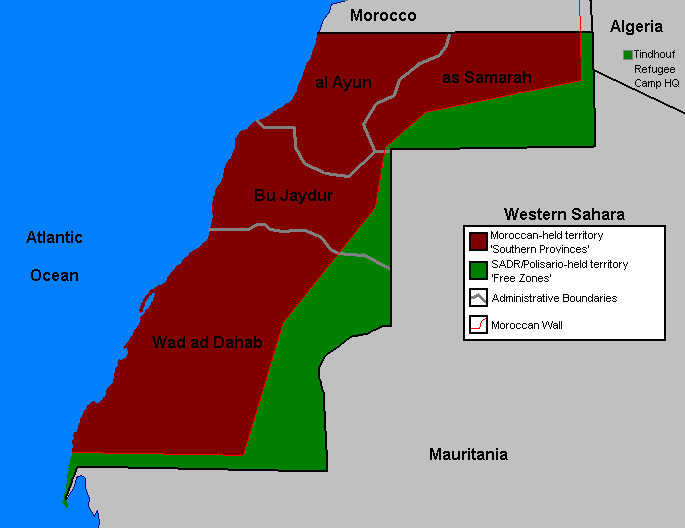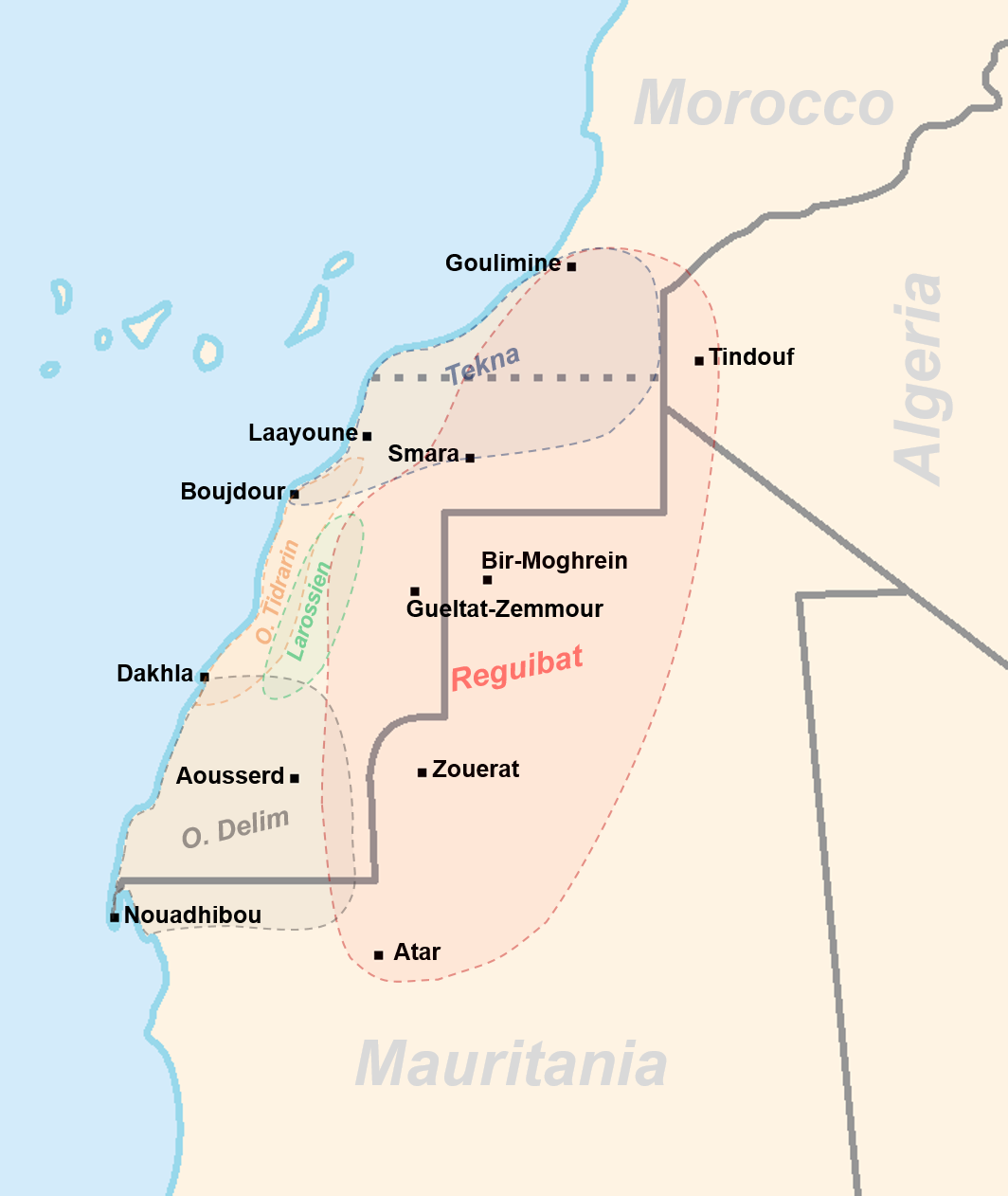|
Tiris Al-Gharbiyya
Tiris al-Gharbiyya () was the name for the area of Western Sahara under Mauritanian control between 1975 and 1979. History Mauritania annexed the southern third of the former Spanish colony of Spanish Sahara in 1975 after the Madrid Accords, with Morocco taking the northern two-thirds ( Saguia el-Hamra and the northern half of Río de Oro) as its Southern Provinces. Both countries claimed historical rights over the area, while the United Nations demanded that the indigenous population ( Sahrawis) had a right to self-determination, and should be allowed to decide through a referendum whether the territory should join either of the neighbouring states, or be established as an independent country. The latter was the preferred option of the Polisario Front, a Sahrawi organization which turned its guerrilla forces against both countries, having until then fought Spain. Its attacks against Mauritania proved highly effective. Polisario strikes against the iron mines at Zouera ... [...More Info...] [...Related Items...] OR: [Wikipedia] [Google] [Baidu] |
Regions Of Mauritania ...
Mauritania is divided into 15 regions (): During the Mauritanian occupation of Western Sahara (1975–79), its portion of the territory (mainly corresponding to the lower half of Río de Oro province) was named Tiris al-Gharbiyya. The regions (''wilaya'') are subdivided into 44 departments; see departments of Mauritania for more information. See also * ISO 3166-2:MR References {{Mauritania topics Mauritania 1 Regions, Mauritania Mauritania, Regions Mauritania geography-related lists Subdivisions of Mauritania * Mauritania Mauritania, officially the Islamic Republic of Mauritania, is a sovereign country in Maghreb, Northwest Africa. It is bordered by the Atlantic Ocean to the west, Western Sahara to Mauritania–Western Sahara border, the north and northwest, ... [...More Info...] [...Related Items...] OR: [Wikipedia] [Google] [Baidu] |
Saguia El-Hamra
Saguia el-Hamra ( , ) is the northern geographic region of Western Sahara. It was, with Río de Oro, one of the two territories that formed the Spanish province of Spanish Sahara after 1969. Its name comes from a waterway that goes through the capital. The wadi is inhabited by the Oulad Tidrarin Sahrawi tribe. Occupying the northern part of Western Sahara, it lay between the 26th parallel north and 27°50'N. The city of Cape Bojador served to divide the regions. Its colonial capital was El Aaiún (Laâyoune), and it also included the city of Smara. The territory takes its name from an intermittent river, the Saguia el-Hamra, the route of which runs west from south of El Farsia to reach the Atlantic at Laayoune Laayoune or El Aaiún (, Latn, ar, al-ʕuyūn , , ) is the largest city of the disputed territory of Western Sahara, with a population of 271,344 in 2023. The city is the ''de jure'' capital of the Sahrawi Arab Democratic Republic, though it .... The area is ... [...More Info...] [...Related Items...] OR: [Wikipedia] [Google] [Baidu] |
Algeria
Algeria, officially the People's Democratic Republic of Algeria, is a country in the Maghreb region of North Africa. It is bordered to Algeria–Tunisia border, the northeast by Tunisia; to Algeria–Libya border, the east by Libya; to Algeria–Niger border, the southeast by Niger; to Algeria–Western Sahara border, the southwest by Mali, Mauritania, and Western Sahara; to Algeria–Morocco border, the west by Morocco; and to the north by the Mediterranean Sea. The capital and List of cities in Algeria, largest city is Algiers, located in the far north on the Mediterranean coast. Inhabited since prehistory, Algeria has been at the crossroads of numerous cultures and civilisations, including the Phoenicians, Numidians, Ancient Rome, Romans, Vandals, and Byzantine Greeks. Its modern identity is rooted in centuries of Arab migrations to the Maghreb, Arab Muslim migration waves since Muslim conquest of the Maghreb, the seventh century and the subsequent Arabization, Arabisation ... [...More Info...] [...Related Items...] OR: [Wikipedia] [Google] [Baidu] |
1978 Mauritanian Coup D'état
The 1978 Mauritanian coup d'état was a bloodless military coup in Mauritania which took place on 10 July 1978. The coup, led by the Army Chief of Staff, Colonel Mustafa Ould Salek, who commanded a group of junior officers, overthrew President Moktar Ould Daddah, who ruled the country since independence from France in 1960. The main motive for the coup was Daddah's ill-fated participation in the Western Sahara War (from 1975 onwards) and the resulting ruin of the economy of Mauritania. Following the coup, Salek had assumed the presidency of a newly formed military junta, the 20-member Military Committee for National Recovery (CMRN). Reports from the capital Nouakchott said no shooting had been heard in the city, and no casualties had been announced. After a period of imprisonment, Ould Daddah was allowed to go into exile in France in August 1979, and was allowed to return to Mauritania on 17 July 2001. Background Moktar Ould Daddah, the first president of Mauritania, ... [...More Info...] [...Related Items...] OR: [Wikipedia] [Google] [Baidu] |
Economy Of Mauritania
The economy of Mauritania is still largely based on agriculture, mining and livestock, even though most of the nomads and many subsistence farmers were forced into the cities by recurring droughts in the 1970s and 1980s. Mauritania has extensive deposits of iron ore, which account for almost 50% of total exports. The decline in world demand for this ore, however, has led to cutbacks in production. With the current rise in metal prices, gold and copper mining companies are opening mines in the interior. The nation's coastal waters are among the richest fishing areas in the world, but overexploitation by foreigners threatens this key source of revenue. The country's first deep water port opened near Nouakchott in 1986. In recent years, drought and economic mismanagement have resulted in a buildup of foreign debt. In March 1999, the government signed an agreement with a joint World Bank-International Monetary Fund mission on a $54 million enhanced structural adjustment facility ( ... [...More Info...] [...Related Items...] OR: [Wikipedia] [Google] [Baidu] |
Mauritania Railway
The Mauritania Railway is the national railway of Mauritania. Construction of the line began in 1960, with its opening in 1963. It consists of a single, railway line linking the iron mining center of Zouérat with the port of Nouadhibou, via Fderik and Choum. The state agency Société nationale industrielle et minière (SNIM) controls the railway line. Since the closure of the Choum Tunnel, a section of the railway cuts through the Polisario Front- controlled part of the Western Sahara (). History The line was a success and provided a major portion of Mauritania's GDP; as a result, the line was nationalized in 1974. Following Mauritania's annexation of southern Western Sahara in 1976, the line came under constant attack by Polisario militia, effectively putting the line out of use and thereby crippling Mauritania's economy. This played a major role in prompting the army to overthrow Mauritanian President Moktar Ould Daddah in 1978, followed by a withdrawal from We ... [...More Info...] [...Related Items...] OR: [Wikipedia] [Google] [Baidu] |
Zouérat
Zouérat () is the largest town in northern Mauritania and the capital of the Tiris Zemmour region, with an approximate population of 62,380 (2023). It lies at the eastern end of the Mauritania Railway to Nouadhibou. History The town developed from its importance to iron ore mining. It is surrounded by the hematite mines of Fderîck, Tazadit and Rouessa. The town houses the regional administration and military for Tiris Zemmour. Most of the town's population are employed directly and indirectly in the mining industry. A sizeable number of foreign workers from other African countries live in the town. Amenities include a medical clinic, social club, pool, school and shop. Since 2006, a shanty town has grown around the town. In response authorities have begun construction of a wall, nicknamed locally as the "''mur de la honte''" (wall of shame), to separate the two areas. Mining Mining at the mountain was first recorded from the Kediet ej Jill in the 11th century, bu ... [...More Info...] [...Related Items...] OR: [Wikipedia] [Google] [Baidu] |
Guerrilla Warfare
Guerrilla warfare is a form of unconventional warfare in which small groups of irregular military, such as rebels, partisans, paramilitary personnel or armed civilians, which may include recruited children, use ambushes, sabotage, terrorism, raids, petty warfare or hit-and-run tactics in a rebellion, in a violent conflict, in a war or in a civil war to fight against regular military, police or rival insurgent forces. Although the term "guerrilla warfare" was coined in the context of the Peninsular War in the 19th century, the tactical methods of guerrilla warfare have long been in use. In the 6th century BC, Sun Tzu proposed the use of guerrilla-style tactics in '' The Art of War''. The 3rd century BC Roman general Quintus Fabius Maximus Verrucosus is also credited with inventing many of the tactics of guerrilla warfare through what is today called the Fabian strategy, and in China Peng Yue is also often regarded as the inventor of guerrilla warfare. Guerrilla wa ... [...More Info...] [...Related Items...] OR: [Wikipedia] [Google] [Baidu] |
Polisario Front
The Popular Front for the Liberation of Saguia el-Hamra and Río de Oro (Spanish language, Spanish: ; ), better known by its acronym Polisario Front, is a Sahrawi nationalism, Sahrawi nationalist liberation movement seeking to end the occupation of Western Sahara through the means of self-determination and Wars of national liberation, armed resistance. Tracing its origin to a Sahrawi nationalist organization known as the Movement for the Liberation of Saguia el Hamra and Wadi el Dhahab, the Polisario Front was formally constituted in 1973 with the intention of launching an armed struggle against the Spanish Sahara, Spanish occupation which lasted until 1975, when the Spanish decided to allow Mauritania and Morocco to partition and occupy the territory. The Polisario Front proclaimed the Sahrawi Arab Democratic Republic (SADR) on 27 February 1976, and Western Sahara War, waged a war to drive out the two armies. It forced Mauritania to relinquish its claim over Western Sahara in ... [...More Info...] [...Related Items...] OR: [Wikipedia] [Google] [Baidu] |
Self-determination
Self-determination refers to a people's right to form its own political entity, and internal self-determination is the right to representative government with full suffrage. Self-determination is a cardinal principle in modern international law, binding, as such, on the United Nations as an authoritative interpretation of the Charter of the United Nations, Charter's norms. The principle does not state how the decision is to be made, nor what the outcome should be (whether independence, federation, protectorate, protection, some form of autonomy or full Cultural assimilation, assimilation), and the right of self-determination does not necessarily include a right to an independent state for every ethnic group within a former colonial territory. Further, no right to secession is recognized under international law. The concept emerged with the rise of nationalism in the 19th century and came into prominent use in the 1860s, spreading rapidly thereafter. During and after World War ... [...More Info...] [...Related Items...] OR: [Wikipedia] [Google] [Baidu] |
Sahrawis
The Sahrawis, or Sahrawi people ( '), are an ethnic group native to the western part of the Sahara desert, which includes the Western Sahara, southern Morocco, much of Mauritania, and along the southwestern border of Algeria. They are of mixed Hassani Arab and Sanhaji Berber descent, as well as West African and other indigenous populations. As with most peoples living in the Sahara, the Sahrawi culture is a mix of Arab and indigenous African elements. Sahrawis are composed of many tribes and are largely speakers of the Hassaniya dialect of Arabic. Etymology The Arabic word ' () literally means "Inhabitant of the Desert". The word ''Sahrawi'' is derived from the Arabic word ' (), meaning "desert". A man is called a Sahrawi, and a woman is called a Sahrawiya. In other languages it is pronounced in similar or different ways: * Berber: ''Aseḥrawi'' or ''Aneẓrofan'' * English: ''Sahrawi'' or ''Saharawi'' * Spanish: ''Saharaui'' (''saharauita'', ''saharauiya'') * Fren ... [...More Info...] [...Related Items...] OR: [Wikipedia] [Google] [Baidu] |
Indigenous Peoples Of Africa
The indigenous people of Africa are groups of people native to a specific region; people who lived there before colonists or settlers arrived, defined new borders, and began to occupy the land. This definition applies to all indigenous groups, whether inside or outside of Africa. Although the vast majority of Native Africans can be considered to be "indigenous" in the sense that they originated from that continent and nowhere else (like all ''Homo sapiens''), identity as an "indigenous people" is in the modern application more restrictive. Not every African ethnic group claims identification under these terms. Groups and communities who do claim this recognition are those who by a variety of historical and environmental circumstances have been placed outside of the dominant state systems. Their traditional practices and land claims have often come into conflict with the objectives and policies promulgated by governments, companies, and surrounding dominant societies. Marginalizati ... [...More Info...] [...Related Items...] OR: [Wikipedia] [Google] [Baidu] |






